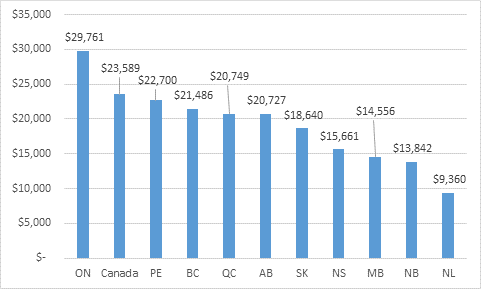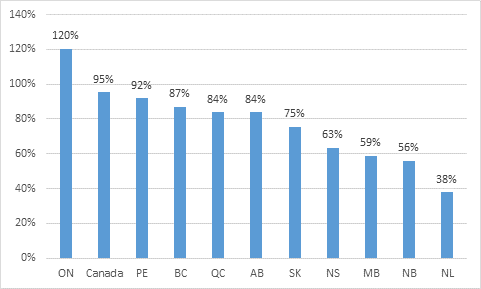Due to a few unexpected issues yesterday, we had to postpone the One Thought. With no further ado, here it is:
The day before yesterday we looked at what universities in different parts of the country are charging in terms of international tuition fees. Here’s a quick graph to refresh your memory:
Figure 1: International Undergraduate Tuition Fees, by Province, Canada, 2016-17
Figure 2 shows the same data but with a different Y axis. Instead of showing the figure in dollars, let’s show the figure as a percentage of national average total institutional expenditures per FTE students (minus sponsored research), which in 2014-15 was $24,732.
Figure 2: Provincial Average Tuition as a percentage of National Average Institutional Expenditures per FTE student
What figure 2 shows is that on average international students are covering more or less (95%) covering the cost of their education through tuition, but that is mostly because of policies in Ontario, where the figure is 120% of cost. In the other three “big provinces” the fees are about 85% of cost, whereas elsewhere the figure is lower; as low as 38% in Newfoundland’s case.
Now, let’s think about these figures in terms of how Canada positions itself as an education market. Are we a bargain player, or a luxury player? This isn’t quite a straightforward question to answer because not everyone reports data in the same way. But, basically, here’s the basic story: in the US according to the College Board’s Trends in College Prices 2016, 4-year private non-profits charge US$33,480 (for both national and international students); out-of-state charges at public 4-year universities are US$24,930. In the UK, international fees vary substantially based on whether the course is a lecture course, a laboratory course or a clinical course; the Times Higher 2016 survey of fees, the average for these three types of courses are, respectively, £13,442, £15,638 and £20,956. In New Zealand, the most recent data available comes from the Education Counts website; according to this, in 2015, the average tuition at universities was NZ$24,150. So far as I can tell there is no “official” average for fees in Australia (not even for domestic students), but this 2014 survey shows that the average in “indicative fee” for international students is A$23,521. Given that a couple of years have passed and fees certainly aren’t going down, we can probably round that up to an even $25,000.
Now, let’s translate all those figures into a common currency. And let’s do it the way an international student likely would; namely, in $USD, using current exchange rates. Normally, I do these kinds of comparisons in $PPP but since international students have to convert money to buy in each currency, exchange rates make more sense. So, at current rates of exchange, here is what the competitive picture in each jurisdiction looks like:
Figure 3: Average International Student Tuition Fees, Selected Jurisdictions, in $USD
In brief, prices for international students in the US are substantially higher than they are elsewhere in the Anglophone world: US privates are charging 85% more than Canadian universities, and the publics are charging about 35% more. National averages for Canada, Australia, New Zealand and UK (lecture courses) are all very tightly bunched together at between $17-18,000 US. Only Ontario seems to be trying to play around the same price point as US publics.
One question that arises from this chart is: why exactly aren’t universities in the rest of Canada charging more? What do Manitoba and Nova Scotia, let alone Newfoundland, gain by having such low fees? Well, part of the story has to do with the way provincial subsidies work in these provinces. In both Manitoba and Newfoundland, institutions get block grants and so all money from international students is “additional” to institutional budgets (I have a feeling this is true in Nova Scotia as well but wasn’t able to confirm before publication). They can set them low because they simply do not need to get income equivalent to cost of education, the way Ontario universities do. But while that might make sense from an institutional point of view, it’s not as clear why that makes sense from a provincial one: what’s in it for provincial governments to provide this level of subsidy for international students?
One possible argument is that these provinces need to price low in order to attract students (Winnipeg winters are perhaps a tough sell in South East Asia); and since education is a funnel for immigration, maybe the way to think about this money is as a “loss leader” for future population growth. But then again, we already know that Atlantic Canada has a harder time hanging on to students after graduation than the rest of the country , so maybe this isn’t such a winning idea after all.n
I’d argue in fact that low-pricing is self-defeating in international higher education. A degree from a (reasonably) prestigious institution is in fact a Veblen good: higher prices drive greater demand because they give an aura of exclusivity. It’s the one type of good where demand curves don’t slope downwards and institutions would be kind of crazy not to take advantage of that. There’s a good case to be made that institutions in the Atlantic and prairie provinces could increase international student tuition.




 Tweet this post
Tweet this post

Somewhat misleading numbers for PEI, probably due to averaging in fees for vet school. Regular undergraduate fees as low as anyone. Internationals now over 20percent of enrolment.
I wondered if that was the case. Thanks for the clarification.